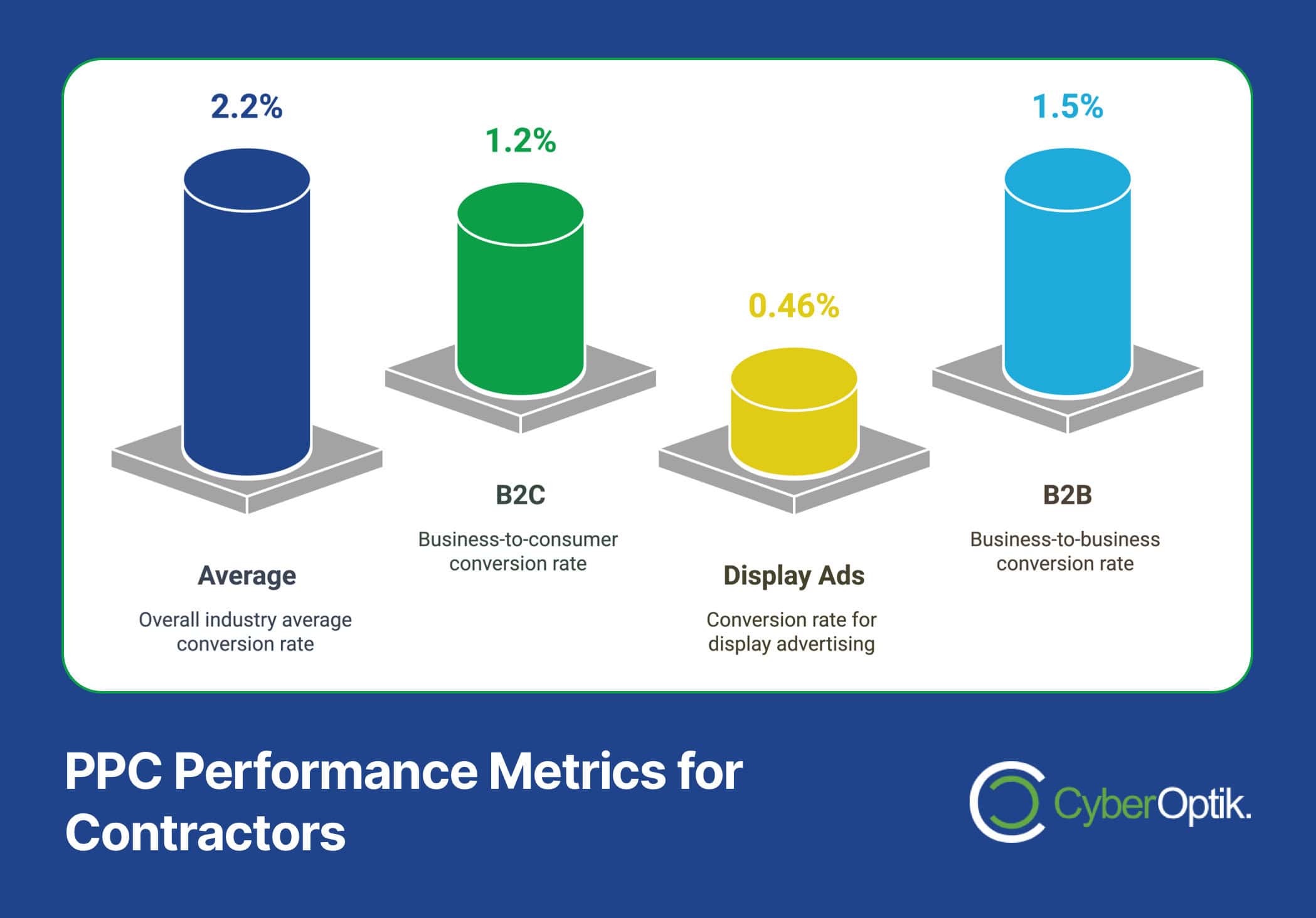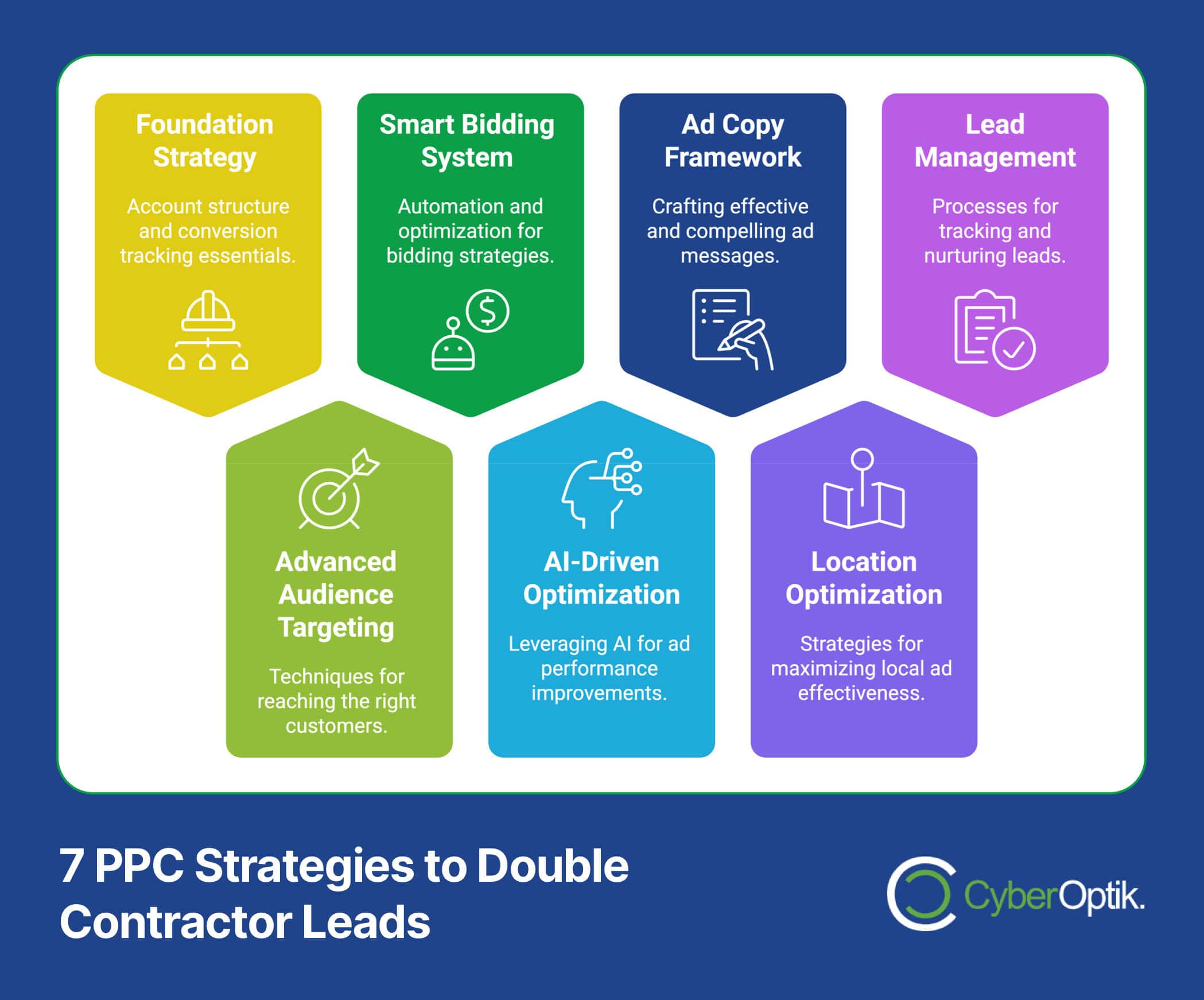PPC advertising transforms how contractors generate leads, with data showing these campaigns convert 50% better than organic traffic alone (Source: Cropink). We’ve witnessed firsthand how contractors struggle with rising ad costs and fierce competition, often spending valuable marketing dollars without seeing proportional returns. Through our work with Chicago-area contractors, we’ve developed a systematic approach to construction marketing that consistently delivers qualified leads.
This guide breaks down seven proven PPC strategies that will help you double your leads in 2025. We’re focusing on practical, implementable tactics backed by real performance data from our contractor clients. These methods work because they combine advanced targeting capabilities with contractor-specific optimization techniques, creating campaigns that capture high-intent leads while maintaining cost efficiency.
Our experience shows that contractors who implement these strategies systematically see significant improvements in their lead generation within the first 90 days. By focusing on each element in sequence, you’ll build a PPC campaign structure that not only attracts more leads but also improves lead quality while optimizing your advertising budget.
The Current State of PPC Advertising for Contractors

The construction industry invests over $10 billion annually in advertising, with PPC advertising claiming an increasingly significant share. Our data analysis reveals that construction companies achieve an average conversion rate of 2.2% through Google Ads campaigns (Source: Sixth City Marketing). This represents a substantial opportunity for contractors who can optimize their campaigns effectively.
We’ve observed a significant shift in contractor PPC performance over the past year. While overall advertising costs have increased, sophisticated targeting options and automation tools have made it possible to maintain and even improve campaign efficiency. The key lies in understanding how to leverage these tools while avoiding common pitfalls that drain advertising budgets.
Competition in the contractor space continues to intensify, particularly in major metropolitan areas. However, this heightened competition hasn’t diminished the effectiveness of PPC campaigns. Instead, it has created an environment where strategic advantage goes to contractors who implement data-driven optimization techniques and maintain consistent campaign monitoring.
The most successful contractors approach PPC as part of an integrated digital marketing strategy. They understand that while paid advertising drives immediate results, the real power comes from combining it with robust tracking systems and lead nurturing processes. This comprehensive approach helps maintain a steady flow of qualified leads while gradually reducing cost per acquisition.
These market conditions set the stage for our first strategy: building a strong PPC foundation. By starting with proper account structure and tracking mechanisms, contractors can create campaigns that consistently generate high-quality leads while maintaining profitable advertising costs.

Strategy #1: Building a Strong PPC Foundation
A robust PPC foundation determines campaign success, which explains why 80% of businesses rely on pay-per-click advertising for growth (Source: WebFX). Our experience with home services marketing shows that contractors who invest time in proper account setup consistently outperform those who rush into campaign creation.
Account Structure Optimization
Your account structure serves as the blueprint for all PPC activities. We recommend organizing campaigns by service type, with separate ad groups for specific services and geographic areas. This granular approach enables precise budget allocation and performance tracking while maintaining quality score metrics that influence ad costs.
Campaign segmentation should reflect your business priorities and seasonal patterns. For instance, roofing contractors might separate emergency repair campaigns from planned replacement projects, allowing for different bidding strategies and ad messaging that matches user intent.
Tracking Setup Requirements
Accurate conversion tracking forms the backbone of performance measurement. Our technical team implements comprehensive tracking systems that monitor phone calls, form submissions, and chat interactions. This multi-touch attribution model reveals which keywords and ads generate the highest quality leads, enabling data-driven optimization decisions.
Beyond basic conversion tracking, we configure advanced metrics such as return on ad spend (ROAS) and cost per qualified lead. These measurements help maintain profitability while scaling campaign reach and impact.
Quality Score Management
Quality Score directly impacts ad placement and cost per click. We focus on three core components: expected clickthrough rate, ad relevance, and landing page experience. By aligning these elements, contractors can achieve better ad positions while maintaining competitive bid levels.
Landing pages require special attention in the contractor space. Each page should mirror the specific service offered in your ads, featuring relevant content, clear contact options, and trust indicators such as licenses and certifications. This alignment between ads and landing pages improves both Quality Score and conversion rates.
With these foundational elements in place, contractors can confidently expand their reach through advanced audience targeting techniques. The next section explores how to identify and connect with your most valuable potential customers using sophisticated targeting capabilities.
Strategy #2: Advanced Audience Targeting
Advanced audience targeting elevates contractor PPC campaigns beyond the industry’s average conversion rate of 1.91%. Our experience in home builder marketing demonstrates that precise targeting significantly reduces cost per acquisition while improving lead quality.
Geographic Targeting Techniques
Geographic targeting requires more sophistication than simply setting a radius around your service area. We implement layered targeting strategies that account for population density, income levels, and historical performance data. This approach allows for bid adjustments based on specific neighborhoods or zones where your services generate the highest returns.
Smart radius targeting considers travel time rather than distance, ensuring your ads appear to customers within practical service boundaries. This becomes particularly valuable in metropolitan areas where traffic patterns and natural barriers affect service accessibility.
Demographics and Behavior Targeting
Demographic targeting goes beyond basic age and gender filters. We analyze homeownership status, household income, and parental status to identify audiences most likely to need contractor services. By combining these factors with behavioral data, such as previous interactions with home improvement content, we create highly focused audience segments.
Our campaigns factor in seasonal behavior patterns and life events that trigger home improvement projects. This anticipatory approach positions your ads in front of potential customers just as they begin their contractor search process.
Custom Intent Audiences
Custom intent audiences capture users actively researching contractor services. We build these audiences using keywords, website URLs, and app usage patterns that indicate high purchase intent. This targeting method proves particularly effective for emergency services and time-sensitive projects.
The power of custom intent audiences lies in their ability to identify potential customers before they make direct contractor searches. By targeting users who browse related content, such as home improvement websites or property maintenance forums, we expand your reach while maintaining relevance.
These advanced targeting capabilities set the stage for implementing smart bidding strategies that optimize your budget allocation. The next section examines how machine learning algorithms can automate bid adjustments for maximum campaign performance.
Strategy #3: Smart Bidding Implementation
Smart bidding transforms contractor PPC campaigns by leveraging machine learning to achieve the industry benchmark of 3.17% conversion rate for search ads (Source: Store Growers). This automated approach forms a crucial component of an effective digital marketing strategy, particularly for contractors managing multiple service areas and project types.
Machine Learning Benefits
Machine learning algorithms analyze thousands of signals in real-time, making bid adjustments based on factors humans simply cannot process manually. These systems evaluate user device types, location context, time of day, and even weather patterns to optimize bid strategies for maximum return on investment.
Our implementation of smart bidding for contractors focuses on maximizing conversion value while maintaining target cost per acquisition. This balanced approach ensures you capture high-value projects without overspending on less profitable leads.
Bid Strategy Selection
Selecting the right bid strategy depends on your specific business goals and conversion tracking capabilities. Target CPA works well for contractors with consistent job values, while Target ROAS proves more effective for services with varying project sizes. We configure these strategies based on historical data and seasonal patterns specific to the construction industry.
Smart bidding requires a minimum conversion threshold to function effectively. We often implement portfolio bid strategies across multiple campaigns to reach these thresholds faster, allowing the system to optimize performance more quickly.
Performance Monitoring
Smart bidding success depends on careful monitoring and adjustment. Our team tracks key performance indicators daily, watching for unusual patterns or seasonal shifts that might require strategy modifications. This vigilant approach prevents the common pitfall of letting automation run unchecked.
We maintain control over automated systems by setting appropriate guardrails and bid limits. These boundaries ensure the algorithms work within profitable parameters while still having enough flexibility to capture opportunities as they arise.
With smart bidding handling the complex task of bid management, your campaigns can focus on creative optimization. The next section covers how AI-driven ad optimization takes your campaign performance to an even higher level by continuously testing and refining ad content.
Strategy #4: AI-Driven Ad Optimization
AI-driven optimization helps contractors exceed the standard B2C conversion rate of 1.2% (Source: Seven Atoms). Our implementation of marketing automation systems shows that AI-powered testing consistently improves ad performance while reducing management overhead.
Data Analysis Tools
Modern AI tools analyze vast amounts of campaign data to identify patterns human analysts might miss. These systems evaluate historical performance across different ad variations, examining how specific phrases, calls to action, and value propositions resonate with different audience segments.
Our AI implementation focuses on identifying the most effective combinations of ad elements for contractor services. The system continuously tests different headlines, descriptions, and extensions, learning from real-world performance data to optimize future ad variations.
Creative Testing
Systematic creative testing remains crucial for contractor PPC success. We employ responsive search ads that automatically test multiple headline and description combinations. This approach allows the AI to discover which messages most effectively drive qualified leads for specific services.
The testing process extends beyond basic ad copy to include various extension formats. AI analysis helps determine which extension types, from call extensions to structured snippets, deliver the best results for different contractor services and locations.
Performance Metrics
AI optimization relies on comprehensive performance tracking. Our systems monitor traditional metrics like click-through rates and conversion rates while also analyzing deeper indicators such as user engagement patterns and lead quality scores. This multi-dimensional approach ensures optimizations improve not just quantity but quality of leads.
We configure custom metrics specific to contractor businesses, such as emergency service response rates and seasonal demand patterns. These specialized measurements help the AI system make more informed decisions about bid adjustments and ad delivery timing.
The insights gained through AI-driven optimization inform our approach to ad copy creation. The next section examines how to craft compelling ad messages that capitalize on these learnings while maintaining strong conversion rates.
Strategy #5: Compelling Ad Copy Creation
Effective ad copy drives both immediate action and long-term brand recognition, with PPC campaigns boosting brand awareness by 80% (Source: Sixth City Marketing). Our experience optimizing contractor websites shows that precisely crafted ad messages significantly improve both click-through and conversion rates.
USP Integration
Unique selling propositions must address specific pain points in the contractor market. We craft messages that highlight emergency response times, service guarantees, and specialized expertise. These differentiators help your ads stand out in competitive search results while attracting qualified leads.
Your ad copy should reflect your company’s strongest competitive advantages. Whether you specialize in rapid emergency response, offer extended warranties, or maintain specific certifications, these unique features become powerful conversion triggers when properly emphasized in ad text.
Call-to-Action Best Practices
Strong calls to action create urgency while maintaining professionalism. We develop action phrases that match the service context, using “Schedule Your Free Inspection” for planned projects and “Get Emergency Service Now” for urgent needs. This contextual approach improves ad relevance and user engagement.
Each call to action aligns with the specific landing page experience, ensuring a seamless transition from ad to conversion. This consistency between ad promises and landing page delivery significantly improves conversion rates while maintaining high quality scores.
Ad Extension Utilization
Strategic use of ad extensions expands your message without increasing core ad costs. We implement location extensions to highlight service areas, callout extensions to showcase credentials, and structured snippets to detail specific services. This comprehensive approach maximizes ad real estate while improving click-through rates.
Price extensions work particularly well for standardized services, while promotion extensions help highlight seasonal offers or special financing options. These additional elements provide valuable information that helps qualify leads before they click.
The success of your ad copy directly influences the effectiveness of location-based targeting. The next section explores how to leverage geographic targeting to maximize local visibility and capture high-intent customers in your service area.
Strategy #6: Location-Based Optimization
Location-based optimization helps contractors surpass the standard display ad conversion rate of 0.46% (Source: WebFX). Our expertise in local SEO demonstrates that precise geographic targeting combined with local service ads dramatically improves campaign performance.
Local Service Ads
Google’s Local Service Ads provide contractors with premium placement and enhanced trust signals. We optimize these campaigns by maintaining high customer satisfaction scores and quick response times. This specialized ad format generates pre-qualified leads while building credibility through the Google Guaranteed badge.
Success with Local Service Ads requires careful management of your Google Business Profile and review strategy. Our systematic approach to review generation and response management helps maintain the high rating scores necessary for optimal ad placement.
Location Extension Setup
Strategic implementation of location extensions connects your physical presence with digital advertising. We synchronize your Google Business Profile with your ad accounts, ensuring consistent information across all customer touchpoints. This integration improves local visibility while providing valuable location-based insights for campaign optimization.
Multiple location management becomes particularly important for contractors serving various neighborhoods or cities. Our location extension strategy includes specific scheduling and bid adjustments based on performance data from different service areas.
Radius Targeting
Sophisticated radius targeting moves beyond simple distance-based parameters. We analyze travel time, service area profitability, and competitive density to create multi-layered targeting strategies. This approach ensures your budget focuses on the most valuable service areas while maintaining coverage for emergency services.
Bid adjustments within radius targeting reflect the unique characteristics of each service area. Higher bids in premium neighborhoods or areas with less competition help maximize visibility where it matters most, while maintaining cost-effective coverage across your entire service territory.
The effectiveness of location-based campaigns directly impacts lead quality and volume. The next section examines how to implement robust lead management systems that convert these geographically targeted prospects into valuable customers.
Strategy #7: Lead Management Systems
Effective lead management systems help contractors exceed the typical B2B conversion rate of 1.5% (Source: First Page Sage). Our approach to conversion optimization shows that systematic lead nurturing significantly improves both conversion rates and customer lifetime value.
Lead Tracking Implementation
Comprehensive lead tracking begins with proper attribution setup. We implement multi-touch attribution models that capture the complete customer journey, from initial ad interaction through final conversion. This detailed tracking helps identify which ad elements and keywords generate the highest quality leads.
Phone call tracking proves particularly valuable for contractors, as many customers prefer direct phone contact. Our call tracking systems record both conversation duration and quality indicators, providing insights that inform bid adjustments and ad copy optimization.
Quality Score Analysis
Lead quality scoring helps prioritize follow-up efforts and optimize ad spend. We develop custom scoring criteria based on factors such as project type, location, and budget range. This systematic approach ensures your sales team focuses on the most promising opportunities while providing data for campaign refinement.
Regular analysis of lead quality scores reveals patterns in customer behavior and campaign performance. These insights guide adjustments to targeting parameters and bid strategies, continuously improving the quality of incoming leads.
Conversion Optimization
Converting PPC traffic requires streamlined lead capture processes. We optimize landing pages and contact forms to minimize friction while gathering essential project information. This balanced approach improves conversion rates without sacrificing lead quality.
Automated lead nurturing sequences maintain engagement with prospects who might not be ready for immediate project starts. These carefully crafted email and SMS workflows provide valuable information while keeping your company top-of-mind for future projects.
The success of these strategies depends on proper implementation timing and resource allocation. The next section provides a practical timeline for rolling out these seven strategies while maintaining campaign performance throughout the process.
Implementation Timeline and Checklist
Successful implementation of these PPC strategies requires careful planning and systematic execution. Our experience providing digital marketing services shows that a phased approach over 90 days yields the best results while maintaining campaign stability.
Phase 1: Foundation Setup (Weeks 1-2)
The initial phase focuses on establishing proper tracking and account structure. During this period, we implement comprehensive conversion tracking, configure analytics goals, and organize campaigns into logical groups. This foundation ensures accurate performance measurement throughout the optimization process.
Account restructuring occurs simultaneously with tracking setup. We organize campaigns by service type and location while establishing proper budget allocation across different ad groups. This systematic approach prevents disruption to existing lead flow during the transition.
Phase 2: Optimization Implementation (Weeks 3-6)
The second phase introduces advanced targeting and bidding strategies. We begin by implementing smart bidding algorithms, allowing them to gather data while maintaining manual oversight. Simultaneously, we refine audience targeting parameters and develop comprehensive ad extension strategies.
Creative optimization starts during this phase with the development and testing of new ad variations. We maintain existing high-performing ads while introducing new messages based on performance data and competitive analysis.
Phase 3: Advanced Features (Weeks 7-10)
The third phase incorporates sophisticated automation and AI-driven optimization. We activate responsive search ads across all ad groups and implement automated bidding strategies based on accumulated performance data. Location-based optimization receives particular attention during this period.
Lead management systems undergo refinement based on initial results. We adjust scoring criteria, enhance nurturing workflows, and optimize the connection between ad campaigns and CRM systems.
Phase 4: Performance Tuning (Weeks 11-12)
The final phase focuses on fine-tuning all implemented elements. We analyze performance data across all campaigns, make necessary adjustments to bidding strategies, and optimize budget allocation based on proven results. This period establishes the foundation for ongoing campaign management.
Success metrics receive final calibration during this phase. We ensure all tracking systems accurately measure both lead quantity and quality, providing clear visibility into campaign performance and return on investment.
Understanding these strategies raises common questions about implementation and results. The following section addresses the most frequent concerns contractors have about PPC advertising.
Frequently Asked Questions
Our experience with PPC campaign management has revealed several common questions contractors ask when implementing these strategies. Understanding these concerns helps ensure successful campaign execution and realistic expectations for results.
What is a realistic budget for contractor PPC campaigns?
Effective PPC budgets for contractors typically start at $2,000 monthly for local service areas. This investment allows proper testing of different ad variations and keywords while maintaining consistent presence during business hours. Budget allocation should reflect your service area size, competition level, and target growth rate.
How long before seeing measurable results?
Most contractors begin seeing improved lead quality within the first 30 days of implementing these strategies. However, achieving optimal performance typically requires 90 days of data collection and optimization. This timeline allows proper testing of different ad variations and accumulation of conversion data for smart bidding algorithms.
Which services should we prioritize in PPC campaigns?
Initial campaigns should focus on your most profitable services with consistent demand. Emergency services often perform well in PPC due to high intent and immediate need. Secondary campaigns can target seasonal services or larger projects with longer sales cycles, using different bidding strategies for each category.
How do we measure campaign success?
Success measurement combines quantitative and qualitative metrics. Beyond basic conversion tracking, we monitor cost per qualified lead, return on ad spend, and lead quality scores. Customer lifetime value calculations help determine the true impact of PPC campaigns on business growth.
What distinguishes successful contractor PPC campaigns?
The most successful campaigns combine precise targeting with strong lead management systems. They maintain consistent ad presence during peak search hours, use location-specific messaging, and implement systematic lead nurturing processes. Regular optimization based on performance data ensures continuous improvement in both lead quality and quantity.
These insights guide our approach to implementing comprehensive PPC strategies for contractors. The conclusion will summarize key action steps and provide guidance for getting started with your own campaign optimization.
Conclusion
Implementing these seven PPC strategies positions your contracting business for significant lead generation growth in 2025. Our digital marketing expertise shows that contractors who systematically apply these methods consistently achieve their lead generation goals while maintaining profitable customer acquisition costs.
Success begins with proper foundation building through accurate tracking and thoughtful account structure. This groundwork supports the implementation of advanced targeting and bidding strategies that maximize campaign effectiveness. The integration of AI-driven optimization and compelling ad copy ensures your messages reach the right audiences at optimal times.
Location-based optimization proves particularly crucial for contractors, as service area targeting directly impacts campaign profitability. When combined with robust lead management systems, these strategies create a comprehensive framework for generating and converting high-quality leads.
Next Steps for Implementation
Begin your PPC optimization journey by auditing your current tracking systems and campaign structure. This assessment will reveal immediate opportunities for improvement while highlighting areas requiring more substantial updates. Focus initial efforts on establishing proper conversion tracking and implementing basic audience targeting.
Consider working with experienced PPC professionals who understand the unique challenges of contractor advertising. Their expertise can accelerate implementation while avoiding common pitfalls that often derail self-managed campaigns. Professional management also ensures your campaigns remain optimized as market conditions and competition evolve.
The contracting industry continues to grow more competitive, making efficient lead generation increasingly crucial for business success. By implementing these proven PPC strategies now, you position your business to capture a larger share of your market while building a sustainable foundation for long-term growth.




